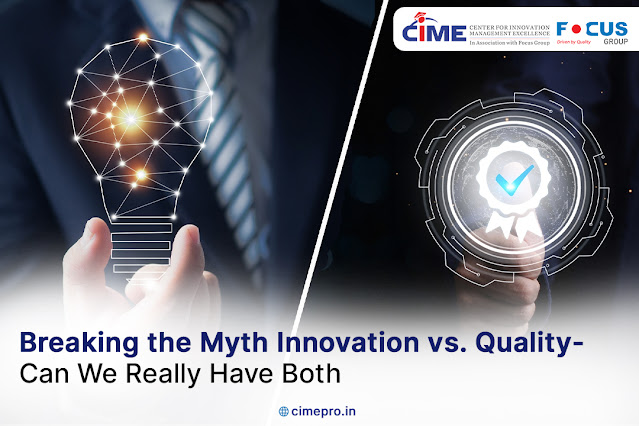Breaking the Myth: Innovation vs. Quality — Can We Really Have Both?
In today’s hyper-competitive world, innovation is no longer optional—it’s a necessity for survival. Whether you're a bold startup founder or a seasoned corporate entrepreneur, the pressure to deliver fast and disrupt faster is relentless. But with this urgency comes a widely held belief: the faster you innovate, the more you risk compromising quality. On the flip side, focusing too much on perfecting quality can slow you down, potentially leaving you irrelevant or too late to market.
This isn’t a
theoretical dilemma—it’s a real-world business challenge. History is filled
with stories of great innovations that failed—not because the idea lacked
brilliance, but because they arrived too early, too late, or with quality gaps
that customers couldn’t overlook.
So, is
innovation truly at odds with quality?
Having spent
years navigating the crossroads of Quality and Innovation Management, I
can confidently say—no, they are not contradictions. In fact, innovation and
quality must co-exist. And the solution lies in adopting a structured approach
to Innovation Training, one that encourages creative thinking without
compromising reliability. One such powerful method is TRIZ (Theory of
Inventive Problem Solving)—a system that helps us break through this
traditional paradox.
Understanding
the Contradiction: Speed vs. Quality
To dissect this
challenge, let’s turn to TRIZ, developed in the 1950s by Genrikh
Altshuller. TRIZ is based on the idea that inventive challenges follow
predictable patterns—and those patterns can be resolved through a set of
defined principles.
In this context,
here’s how the contradiction unfolds:
- Improving Parameter: Speed of innovation and implementation
- Worsening Parameter: Reliability and quality of the final output
Most companies
resort to a compromise. But TRIZ says: don’t choose—innovate to resolve the
contradiction. With tools like the TRIZ Contradiction Matrix and its 40
Inventive Principles, businesses can pursue both speed and quality.
Three TRIZ
Principles That Resolve the Innovation-Quality Trade-off
1. Principle
#10 – Preliminary Action
“Do all
necessary preparations before they are needed.”
This principle
emphasizes preparation. Lay down a strong foundation so innovation can be fast
without being fragile.
How to apply
it:
- Set up modular tech platforms
- Automate quality checks through
CI/CD pipelines
- Use standardized checklists to avoid
missed steps
Example: Tesla’s Gigafactories are designed for modular expansion. This
allows them to scale new models rapidly while maintaining consistent quality.
2. Principle
#3 – Local Quality
“Different parts
of a product/system should have different levels of quality.”
Not every
element of your innovation needs to be perfect at launch. Focus quality efforts
where they matter most to users.
How to apply
it:
- Concentrate on mission-critical
features
- Launch with a Minimum Lovable
Product (MLP), not just an MVP
- Fix secondary components in
post-launch iterations
Example: Early versions of Airbnb had a clunky interface, but their core
value—the seamless booking experience—was flawless. That’s what won users over.
3. Principle
#21 – Skipping or Streamlining Harmful Phases
“Eliminate or
compress steps that don’t add real value.”
Often, speed
gets killed by legacy processes. Not every step in traditional workflows
contributes to customer satisfaction.
How to apply
it:
- Remove redundant documentation
- Replace complex approvals with agile
governance
- Use iterative sprints for feedback
and testing
Example: Agile teams across industries now rely on lean processes like
sprint planning and daily stand-ups to maintain momentum without compromising
deliverables.
A Real-World
Framework: Iterate with Integrity
While principles
like TRIZ offer direction, a successful innovation strategy also requires an
operational culture that supports Innovation
Training. Here’s a practical framework that organizations can adopt:
- Ideate Boldly
Encourage risk-taking and creative brainstorming. Use hackathons or design sprints to explore disruptive ideas. - Implement Rapidly
Adopt agile methodologies to push prototypes quickly. Speed is critical, but it must be guided. - Inspect Smartly
Set strategic quality gates instead of checking everything. Use automated tools and customer feedback to fine-tune efficiently. - Improve Relentlessly
Constantly evolve. Conduct retrospectives, review feedback, and refine your innovation processes.
This iterative
approach ensures you don’t trade off speed for quality—or vice versa.
Reframing the
Narrative: Innovation Needs Quality
Let’s challenge the myth again: Does speed
kill quality?
Not necessarily. In fact, it’s the absence of quality that kills
innovation. Innovation may attract your first customers—but only quality
ensures they stay.
As Lee Iacocca,
former head of Chrysler, rightly said:
“Styling is
what sells a car. Quality is what keeps it sold.”
We could
rephrase that for today:
“Innovation
may win attention. But only quality earns trust.”
The Bigger
Picture: Innovation Training for India’s Growth
India’s startup
ecosystem is booming, and the pace of digital transformation is accelerating
across industries. Now more than ever, structured Innovation Training is
essential to create future-ready leaders.
That’s where
institutions like CIMEPRO Institute, a Certified Training Partner,
are stepping in. Through their globally benchmarked programs, professionals are
learning how to integrate innovation with practical quality management tools
like TRIZ, Lean Thinking, and Design Thinking.
By nurturing
innovation leaders who can move quickly and deliver excellence, CIMEPRO
Institute is helping Indian enterprises compete on a global scale.
There Is No
Real Contradiction
The clash
between innovation and quality is not a deadlock—it’s an opportunity for
inventive thinking. With tools like TRIZ, and support from leading
platforms such as CIMEPRO Institute,
businesses don’t have to choose between being fast or flawless. They can be
both.
Because in the end, quality isn’t what
slows innovation—it’s what sustains it.
Those who understand this truth will not only survive—but thrive in the future
of business.






Comments
Post a Comment